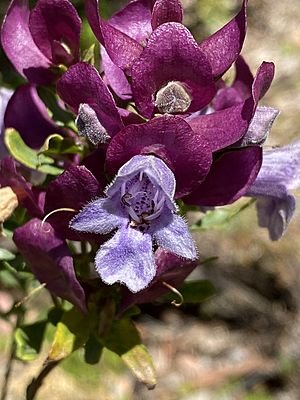Eremophila magnifica facts for kids
Quick facts for kids Eremophila magnifica |
|
|---|---|
 |
|
| Flowers in the ANBG | |
| Scientific classification | |
| Genus: |
Eremophila (plant)
|
| Species: |
magnifica
|
Eremophila magnifica is a beautiful flowering plant that belongs to the figwort family. It is found only in Western Australia. This plant is an upright shrub with big leaves that grow close together. It has large, pretty lilac or purple flowers. Sometimes these flowers grow so tightly that they look like a big bunch of flowers at the end of the branches.
Contents
About the Magnificent Eremophila
Eremophila magnifica is an upright shrub that usually grows to be about 0.5 to 1.5 meters (about 1.5 to 5 feet) tall. Its leaves have a strong nutmeg smell when you crush them. They are packed closely together near the ends of the branches. These leaves are bluish-green and shaped like a spear, usually about 2.9 to 6.3 centimeters (about 1 to 2.5 inches) long and 0.6 to 1.5 centimeters (about 0.2 to 0.6 inches) wide. The edges of the leaves are a bit hairy.
The flowers grow in groups of 2 to 4. They are found close to the ends of the branches, growing from where the leaves meet the stem. Each flower group sits on a hairy stalk that is about 1 to 2.7 centimeters (about 0.4 to 1.1 inches) long. There are 5 green to dull purple, hairy, thin leaf-like parts called sepals, which are mostly 1.1 to 2.2 centimeters (about 0.4 to 0.9 inches) long. The petals are about 1.7 to 2.2 centimeters (about 0.7 to 0.9 inches) long and are joined at the bottom to form a tube. The outside of this petal tube is lilac, and the inside of the petal tips is a deeper lilac. The petal tube and tips have see-through spots. The outside of the flower is hairy, but the inside of the petal tips is smooth. The inside of the tube is full of long, soft hairs. The 4 stamens (the parts that make pollen) are completely hidden inside the petal tube. This plant flowers from August to November. After flowering, it produces dry, oval-shaped fruits that are about 0.65 to 0.75 centimeters (about 0.25 to 0.3 inches) long.
How it Got its Name
This plant was first officially described in 2007 by a scientist named Robert Chinnock. He published his description in a book about Eremophila plants. The second part of its scientific name, magnifica, comes from a Latin word. It means "noble," "important," or "splendid." This name was chosen because of the plant's large and beautiful flowers.
In the same book, Robert Chinnock also described two slightly different types of Eremophila magnifica, which are called subspecies. These names are officially accepted:
- Eremophila magnifica subsp. magnifica: This type has smooth branches and leaves (except for the edges).
- Eremophila magnifica subsp. velutina: This type has velvety branches and leaves.
Where it Grows
The subspecies magnifica grows on the tops and sides of the Hamersley Range in the Pilbara region of Western Australia. It likes rocky slopes and hilltops.
The subspecies velutina is found between Marandoo and Newman. It grows in the Gascoyne and Pilbara regions. This type prefers slopes and temporary creeks where the soil is loamy (a mix of sand, silt, and clay).
Is it Endangered?
The Western Australian Government's Department of Parks and Wildlife says that Eremophila magnifica as a whole is "not threatened." However, the two subspecies have different statuses:
- Subspecies magnifica is listed as "Priority Four." This means it is rare or almost threatened, but not in immediate danger.
- Subspecies velutina is listed as "Priority Three." This means it is not very well known and has only been found in a few places, but it is not currently in immediate danger.
Growing This Plant
The Eremophila magnifica is a great plant for gardens because of its strongly scented leaves and its large, pretty flowers. You can grow it by joining a piece of it onto the rootstock of another plant called Myoporum. It grows best in soil that drains well and in full sunlight. This plant can handle dry conditions, but it is very sensitive to frost. If you prune it, do so very lightly.

